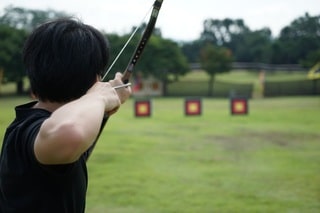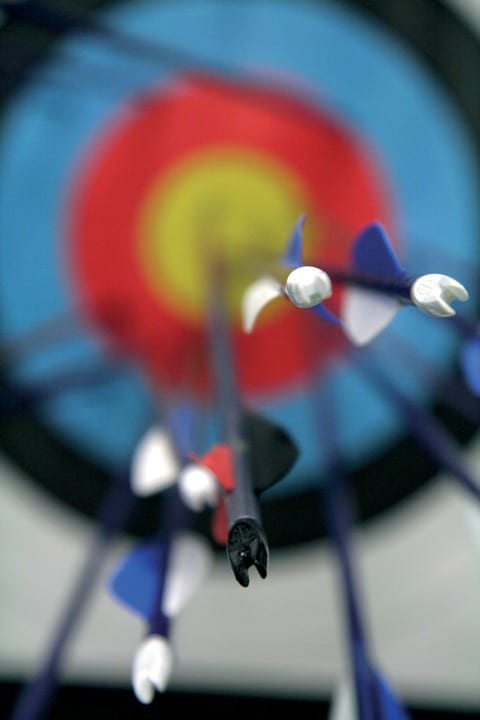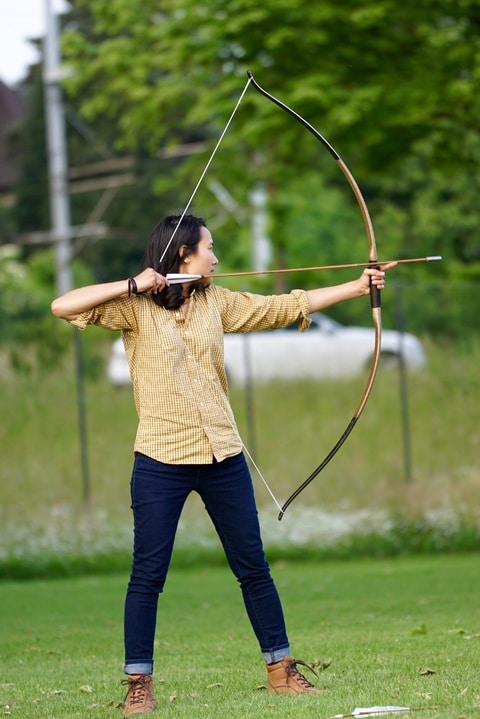When you feel that the accuracy of a recurve bow really affects your aimed spot, you might be thinking about tuning your recurve bow. You might feel the same when your recurve bow is improperly tuned. You might be interested in knowing how to tune a recurve bow because you were experiencing several difficulties while repeating same shots several times and want to pick up a different kind of shot.
By tuning, you can expect highly accurate results from your bow only when you have turned it the correct way. Your attitude, biomechanics of the bow and tuning of the bow are the major aspects which affect the accuracy of your shot from the recurve bow. The first two are natural since they depend on yourself and your bow choice, but for the third aspect, you need to perform the tuning of your bow yourself to ensure maximum accuracy.
We will be presenting you the ultimate guide to tuning a recurve bow when you keep going further throughout this article. Before getting onto the exact step-by-step details, let’s get started with the basics of bow tuning.
What is Bow Tuning?
When you are into the archery field, it really depends on the bow for providing a proper momentum to the arrow. Bow is the most important thing to result in accurate shots at aimed targets. Its design also makes differences in the velocity offered to the arrow to travel the arrow faster or slower. For a better experience in all these things to improve the speed and accuracy of your shots, tuning your bow is highly essential.
Bow tuning refers to the proper method of adjustment of a bow so that your shots can hit the target precisely. Bow tuning needs to be performed in the way you use your bow for shooting so that you’d be able to get the best experience out of your shots. When you have properly tuned a bow, you’d be able to witness a proper arrow flight to provide you a better shooting experience. This is the reason why tuning a bow is really essential along with the consistency in your shooting technique.
[amazon box= “B01FH777JC”]
Why Is Bow Tuning Necessary?
Generally, bow tuning is all about increasing the accuracy of your shots. There are several reasons why it is highly essential in archery which are listed below:
- It allows you to experience a better shooting performance.
- It helps in increasing the velocity offered to the arrows for the perfect shot.
- Tuning a bow can result in highly accurate results at aimed spots.
- It helps to improve your shooting technique by maintaining consistency.
- It makes it easier for you to throw out some straight shots to the aimed spot.
How To Tune A Recurve Bow?
Now that you’ve found out about the significance of tuning a bow, you might want to find out the exact method to tune your recurve bow. When you keep going through this guide below, you will find out the step-by-step information for tuning a recurve bow.
Getting Started
The first thing you need to do get started is to adjust the height of the string from the riser. Generally, this area is around 7 to 9 inches long from the bow’s grip to the bow’s riser. When you have located the string height, you need to pull off some shots with your bow and arrows for testing purposes.
Remember! The arrows need to be fletched.
You will find out proper insights regarding the functioning of your recurve bow when you witness the way the arrows hit the aimed spot. You will also find out the necessary adjustments to be done which will help in improving the accuracy of your shot.
When you are tuning a recurve bow, the nock height also needs to be well-polished since this helps to improve the accuracy of your shot as well as to increase the effectiveness of arrow release.
Preparing A Brace Height
Brace height refers to the total distance between the central part of your bow string and the bow’s grip. To find out the exact method to establish an ideal brace height, you might want to consult the user manual provided by your manufacturer since it is likely to have such information in the manual.
The Initial Steps
When you are ready to make adjustments in the brace height to make it longer, you need to remove the bowstring along one of the bowstring nocks and pull it off. Now, you need to twist the string so that you can shorten it. When you have twisted the string, the next thing you need to be doing is to replace the bowstring end in your bow’s nock location. Now that you have established a proper brace height, you might want to pull off some shots with an arrow to determine how it feels.
You would be to hear some vibration in the limbs of your bow when it is likely that the brace height is too low. The bowstring might even slap your forearm when you throw the shot towards the target. In this case, your bow might turn out to produce a loud noise since there’s no proper brace height for accuracy.
Final Adjustments
In such conditions, you need to keep making adjustments to the brace height. Once you have twisted the bowstring around 3-5 times for shortening it, you might be able to get a proper brace height. To be sure about a proper brace height, you need to make sure that the above-mentioned issues aren’t witnessed.
[amazon box=”B06W9P8QWK”]
Now that you have completed all the steps properly, you’d be able to experience the sweet spot as named by professional archers. When you have made a proper brace height adjustment, you won’t be able to witness any vibration in the limbs, shocks in your forearm and loud noise. With that being done, you have now tuned the brace height in a proper way.
Setting Up The Bow’s Nock Set
The first thing you need to do here is to hold the bow facing toward the ground. An arrow needs to be fitted in the nock, facing towards the ground. Now, you need to tap the bowstring which should result in the dropping away of the arrow from the bowstring quickly. If this doesn’t happen, you might want to consider using a little sandpaper of 150 or 220 grid and sand the nock so that the connection between the nock and the string becomes loose.
Other Alternatives You Can Try Out
Instead of doing so, you might want to use plastic nocks and place them on the arrow shaft just to put them in boiling water until you reach to the base of the arrow groove. You need to keep doing this for around 15 seconds and remove from the water. Now, you should keep them onto the bowstring and let the tight nock to stay there for around 30 seconds so that the nock gets loose to fit in a suitable way.
To set the nock set and position the arrow, you can also use a T-square. You can do so by pulling off some shots with your bow and arrows to determine the shot and position which offer the best accuracy. You need to use both fletch and unfletch arrow one by one so that you will find out the condition of your bow setup.
The Next Thing You Need To Do
With that being done, you can pull off some practice shots staying around 10 meters from the target. In case you feel like the fletched arrows are higher than the unfletched ones after reaching the target, you need to know that your nock is too high. In this case, you need to adjust the setup around 0.79375millimetersr just to try out some shots again. Until you obtain the required accuracy, you need to keep following these steps repeatedly.
If you are left-handed and you are receiving the unfletched arrows to the left of fletched arrows, you need to know that your arrows are a lot more stiffer. You can lower the nock point and make some adjustments in case your unfletched arrows are located below the fletched ones. If they are in the right, then the arrows must be less stiff.
Adjusting Through Arrow Weight
You can adjust your arrow stiffness by shooting with a varying weight of arrows at the beginning. If you want to weaken the arrow, you can insert a heavier point into it and a lighter point in case of a stiff arrow. You might also want to shorten the arrow by 1.5″ every time so that you will be able to get the fletched arrows in the proper alignment.
If you are new to archery, you can keep doing the steps staying at the distance of around 20 meters and 9 meters if you are well-known about archery. When you keep performing these processes repeatedly, you’d be able to have a finer tuning of your recurve bow. When everything is done correctly, your recurve bow will be properly tuned for an increased accuracy and better arrow flight.
Precautions While Tuning A Bow
Despite being well-known about the method to tune a recurve bow, there are still some things you need to do know. You need to consider several things while tuning a bow. Here are some of the major precautions you need to take while tuning a bow:
- You need to keep your arrow aimed towards the earth after nocking.
- Before shooting with your bow, you need to check whether there is any damage in bow limbs or not.
- You shouldn’t point your recurve bow at anyone, even though it is just for testing purposes without loading an arrow.
- You shouldn’t pull and release the string of your bow without loading an arrow in it.
- Wearing an arm guard is recommended if you are new to archery since you might hurt your forearm several times.
- You need to have your cellphone next to you which might be essential in case any sort of accidents take place.
- You need to ensure about un-stringing the bow when you have completed the session.
Conclusion
Now that you have known about the exact method to tune a recurve bow, you are now ready to get started with the tuning process. However, you need to make sure to read the precautions once before tuning a bow to prevent from any sort of damage that might happen.
It might be difficult to tune a bow properly since you have to pull off a few shots, twist and attach your bow string and repeat the same process many times. But, if you try it once and become able to tune your recurve bow, you won’t have any issues later on.
If you have any issues regarding the tuning of your recurve bow, you can feel free to write down to us in the comments. We’d love to get back to you right away.




